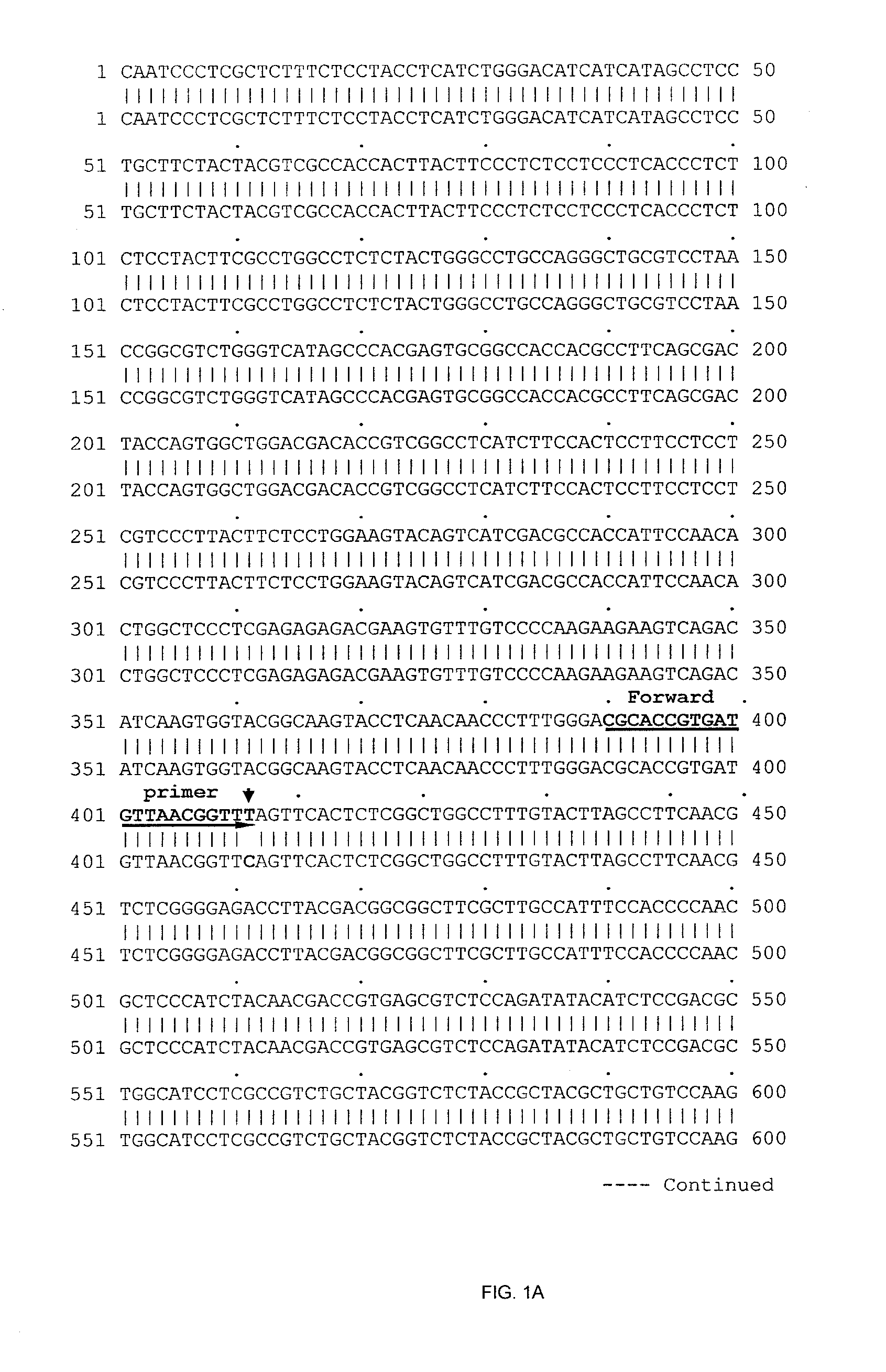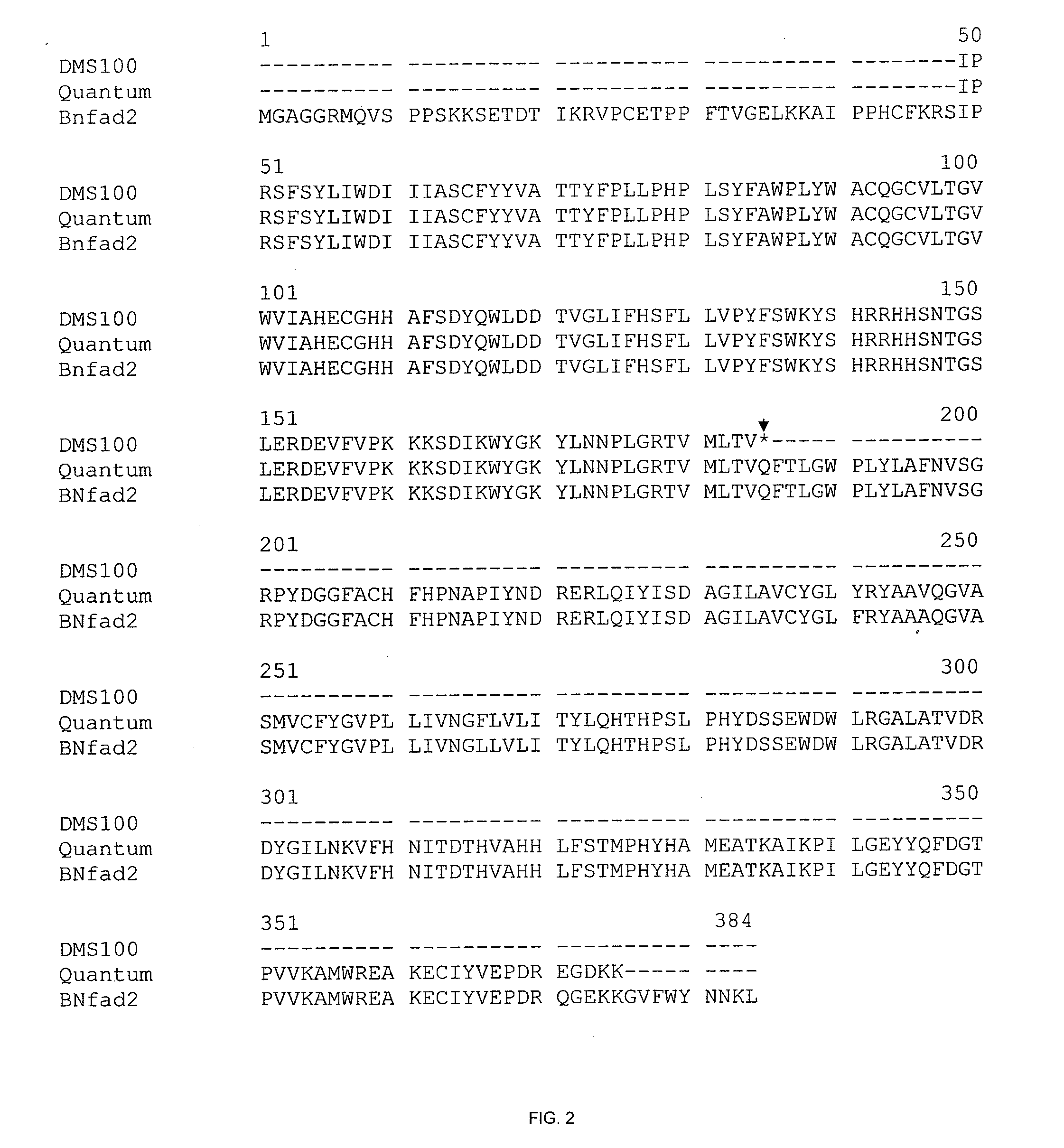Ho/ll canola with resistance to clubroot disease
a technology of clubroot disease and canola, which is applied in the field of plants resistant to diseases, can solve the problems of wilting leaves, serious problems, and stunting through reduced growth
- Summary
- Abstract
- Description
- Claims
- Application Information
AI Technical Summary
Benefits of technology
Problems solved by technology
Method used
Image
Examples
example 1
Materials and Methods
[0126]Plant Material
[0127]Canola varieties DMS100 (mutant type) and Quantum (wild type) were used in this study for cloning of fad2 (fatty acid desaturase-2) and fad3 (fatty acid desaturase-3) alleles. DMS100 is a HO / LL (High Oleic and Low Linolenic) line with oleic acid content at about 77% and linolenic acid content at about 3%. DMS100 is derived from an F4 bulk of a single F3 plant selection originating from the cross of Global×AG019 sister line. Quantum is a commercial variety and contains low oleic acid (˜66%) and high linolenic acid (˜7%) content. A doubled haploid (DH) population was developed by microspore culture from F1 plants of the cross between canola line Quantum and DMS100. The DH population comprised of 604 lines. A complete fatty acid analysis of the seeds of the DH lines and their parents was implemented by using gas chromatography. Of the 604 DH lines, 183 were randomly selected for marker analysis and mapping.
[0128]Genomic DNA Extraction and ...
example 2
Cloning of fad2 and fad3 Alleles
[0138]Genomic DNA fragments from the fad2 gene of parental B. napus lines, DMS100 (mutant) and Quantum (wild-type), were amplified by using primers homologous to Arabidopsis or B. rapa fad2 gene sequences. Tanhuanpää et al. (1998), supra. FIG. 1. The fad2 fragments amplified from each of the parents by the primers FAD2-2F and FAD2-6R were cloned and sequenced. This primer pair amplified a fad2 fragment of the same length (986 bp) from each of the two parents. The sequences of these two primers are:
FAD2-2F:CAATCCCTCGCTCTTTCTCCTACC(SEQ ID NO: 1)FAD2-6R:CCTTTCTTGTCACCTTCCCTGTCC(SEQ ID NO: 2)
[0139]Between the two parental lines, a single nucleotide substitution mutation was identified at position 411 of the fad2 gene. FIG. 1. The wild-type Quantum fad2 gene contains a “C” nucleotide at position 411. However, the HO / LL DMS100 fad2 gene contains a SNP at the same position, wherein the nucleotide is changed to a “T.” The presence of a “T” at this position in...
example 3
Mutant Allele-specific SNP Markers for fad2 and fad3 Genes
[0144]The single nucleotide mutations present in the fad2 and fad3 genes were used as SNP markers to tag the fad2 and fad3 genes for selection of high C18:1 and low C18:3 in canola breeding. Mutant-specific primers (FAD2GM: CGCACCGTGATGGTTAACGGTTT (SEQ ID NO:5); and FAD3cGM: ATAAATAATGTTGATCTACTTAT (SEQ ID NO:15)) were designed in order to detect mutant alleles of fad2 and fad32 using PCR amplification. The primers were designed such that the mutated base (SNP) was at the 3′ end of one of the primers for allele-specific PCR amplification. FIGS. 1 and 3.
[0145]The primers specific to fad2 amplified a polymorphic band that was present in DMS100 and DNA bulks for high oleic acid (C18:1), but were absent in Quantum and the DNA bulks for low oleic acid. FIG. 4. This gene-specific marker was tested on a DH population derived from the cross of Quantum and DMS100, where it was found that the allele distribution was highly correlated t...
PUM
| Property | Measurement | Unit |
|---|---|---|
| Fraction | aaaaa | aaaaa |
| Fraction | aaaaa | aaaaa |
| Length | aaaaa | aaaaa |
Abstract
Description
Claims
Application Information
 Login to View More
Login to View More - R&D
- Intellectual Property
- Life Sciences
- Materials
- Tech Scout
- Unparalleled Data Quality
- Higher Quality Content
- 60% Fewer Hallucinations
Browse by: Latest US Patents, China's latest patents, Technical Efficacy Thesaurus, Application Domain, Technology Topic, Popular Technical Reports.
© 2025 PatSnap. All rights reserved.Legal|Privacy policy|Modern Slavery Act Transparency Statement|Sitemap|About US| Contact US: help@patsnap.com



